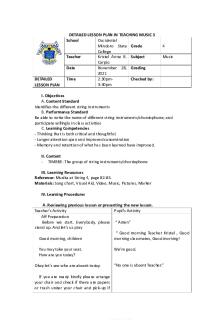Lesson Plan - Maths - Year 3 - Division PDF

| Title | Lesson Plan - Maths - Year 3 - Division |
|---|---|
| Author | Tara O'Malley-Hughes |
| Course | School Experience 1B |
| Institution | University of Northampton |
| Pages | 3 |
| File Size | 89.6 KB |
| File Type | |
| Total Downloads | 86 |
| Total Views | 143 |
Summary
Lesson Plan - Maths - Year 3 - Division...
Description
Lesson/Session Plan
Date/time: 7th June 2017
Class/Grp:
Curriculum area: Mathematics
Risk Assessment/Health & Safety issues (Part II):
Year 3
Content summary: Division – written formal method Learning objectives/intentions TS1,2 (what the children will learn (know/understand/be able to do):
n/a
To be able to build on from yesterday’s lesson and work more independently to solve equations using the written formal method of division.
Success criteria (how the children will know whether they have been successful in their learning): By getting the correct answer using the written method of division. Particular focus for assessment TS6:
Timing
Key vocabulary TS3: Divide, share, sharing, split, halve, times, inverse
Pupil learning activities/ organisation TS2,5
Introduction/starter Children asked to recap with their talking partners what they learnt the previous lesson.
Teaching role (key rich questions, planned AfL, mini-plenaries, modelling, demonstration, classroom management, TA role) Teacher to ask children to recap what they remember about the formal written method of division from the previous lesson.
Main part(s) of lesson Children asked to focus on a PowerPoint and encouraged to join in.
Teacher to show pupils a PowerPoint on division, and then asked to answer as they go along to refresh their memory. Children then asked to try some questions on their own, trying to avoid using resources where possible in order to reinforce concrete understanding.
Learning review/plenary(you can have mini plenaries throughout lesson) TS6 Go through a word equation as a class.
Teacher to present a question in the form of a word equation to the pupils and all are to complete it as a class, talking through every step together and eventually putting it on the working wall for future reference.
Differentiated learning outcomes TS5,8 (T/TA focus groups, ability range, particular groups or individuals (EAL/G&T/SEND): TA to work with SEN children in order to build on their understanding from previous lesson. 13
Resources TS6: Counting beads, building blocks, multilink, worksheets, pencils, rubbers.
14
Lesson/Session Evaluation TS4 Date:
Lesson content:
What went well/was successful in the lesson?
What did the children learn? Did all the children make progress and achieve the learning objective(s)? How do you know? Identify exactly what progress was made:
How did your teaching enable children to make progress?
Did any children make less than expected progress? Why?
Notes for next lesson:
What could have gone better in planning/learning/teaching?
Notes for next lesson:
Annotate your lesson plan to show what you have changed as a result of your reflection.
15...
Similar Free PDFs

Maths Lesson Plan
- 8 Pages

Lesson Plan 3- Edtpa
- 4 Pages

MATHS CHAPTER 2 YEAR 10
- 64 Pages

Lesson plan in Music 3
- 9 Pages

4 Year Plan - my 4 year plan
- 2 Pages
![Lesson plan 3 Monday[ 9821]](https://pdfedu.com/img/crop/172x258/1o20o0vd72n0.jpg)
Lesson plan 3 Monday[ 9821]
- 5 Pages

Lesson Plan
- 8 Pages

Lesson plan
- 5 Pages
Popular Institutions
- Tinajero National High School - Annex
- Politeknik Caltex Riau
- Yokohama City University
- SGT University
- University of Al-Qadisiyah
- Divine Word College of Vigan
- Techniek College Rotterdam
- Universidade de Santiago
- Universiti Teknologi MARA Cawangan Johor Kampus Pasir Gudang
- Poltekkes Kemenkes Yogyakarta
- Baguio City National High School
- Colegio san marcos
- preparatoria uno
- Centro de Bachillerato Tecnológico Industrial y de Servicios No. 107
- Dalian Maritime University
- Quang Trung Secondary School
- Colegio Tecnológico en Informática
- Corporación Regional de Educación Superior
- Grupo CEDVA
- Dar Al Uloom University
- Centro de Estudios Preuniversitarios de la Universidad Nacional de Ingeniería
- 上智大学
- Aakash International School, Nuna Majara
- San Felipe Neri Catholic School
- Kang Chiao International School - New Taipei City
- Misamis Occidental National High School
- Institución Educativa Escuela Normal Juan Ladrilleros
- Kolehiyo ng Pantukan
- Batanes State College
- Instituto Continental
- Sekolah Menengah Kejuruan Kesehatan Kaltara (Tarakan)
- Colegio de La Inmaculada Concepcion - Cebu







